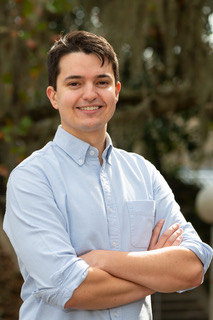Leveraging AI to increase the value of museum collections

Nicolas Gauthier
Earlier this year, Nicolas Gauthier joined the Florida Museum of Natural History as its first curator of artificial intelligence, part of a broad initiative by the University of Florida to spur innovation in AI and data science.
Gauthier has spent over a decade studying the cultural history of ancient civilizations and the ways in which people have interacted with their environments and each other over long periods of time. But Gauthier doesn’t consider himself a traditional archaeologist.
“I don’t really go into the field, but I’m someone who knows that data and can work with it,” he said. “My goal with my research is to take archaeological data, translate it and make it useful to people in multiple disciplines.”
The translation of data and concepts across fields of science and the interdisciplinary collaborations that form as a result have led him down a variety of research avenues, in which he’s tackled old problems with new technology. “I don’t focus on a specific culture. Instead, I try to get up to speed with a new dataset or time period or culture as quickly as possible.”
Those cultural contexts have ranged from Mediterranean hunter-gatherers at the tail end of the Pleistocene through the advent of farming to the disruptive effects wrought by a changing climate on Indigenous communities in the American Southwest. In each case, Gauthier looks for parallels that run through vast spans of time and space. The solutions to the modern issues of sustainability, environmental stewardship and climate change, he contends, lie mirrored in the ways our ancestors dealt with the same problems.
“People’s default notion is that the past was very different, that if you don’t have wheels or electricity there’s no connection we can draw. But time and again, if you go back to cases in which people wrote things down, the parallels are eerily similar,” he said.
This peculiar tendency for patterns to repeat themselves isn’t restricted to periods of time. An entire field of science called complexity theory deals with the ways in which patterns repeat across scales of size and seemingly unrelated subject matters. These unifying patterns are precisely what make AI — which, at its core, looks for simple patterns in complex data — such a powerful tool for understanding the natural world.
For any given study, Gauthier analyzes data by borrowing models from disparate fields, ranging from the natural sciences to industry to national security. While attempting to reconstruct trade networks of prehistoric communities in the American Southwest, he analyzed more than 4 million ceramic artifacts spread out among hundreds of archaeological sites. To make sense of all this data, he constructed a model stitched together from equations that describe gene flow, the hierarchies within terrorist networks and recommendation algorithms used in the entertainment industry. “All of these methods are very similar; it’s just that people use different words to describe them,” he said.
The similarities across disciplines have allowed Gauthier to work with people from different academic backgrounds, all bringing their own unique skillsets and specialties to bear on a shared set of research questions. A formative experience in his career was his time spent as a postdoctoral associate at the Laboratory of Tree-Ring Research at the University of Arizona. “It was an amazing place to be because you have archaeologists, ecologists and climatologists all in the same room working on the same problem,” he said.
With over 40 million specimens and artifacts, the Florida Museum was a natural place for Gauthier to further develop machine learning methods to increase the value and utility of collections. Not only is AI well suited to digging out patterns in messy data, it can also extend those patterns across glaring gaps or omissions that make wider inferences about a particular time period or culture particularly challenging.
“With archaeological data and museum collections, you have this excellent, fine-grained window, like a single archaeological site. But scaling that up to understand entire regions or entire histories of peoples is difficult. That’s where AI methods come in handy. They allow you to fill in the gaps in our knowledge much more easily,” he said.
Gauthier recently submitted a grant application with colleagues in the Museum and UF’s College of Engineering and the Department of Landscape Architecture for the use of light detection and ranging (LIDAR) and machine learning to detect archaeological sites in Guatemala. Down the road, he sees endless opportunities for leveraging AI to reconstruct histories and past climates using natural history collections.
“That’s what really attracted me to the museum,” he said. “These collections are a shared language that we can use to really break down disciplinary boundaries and limitations on how we think about the world.”
